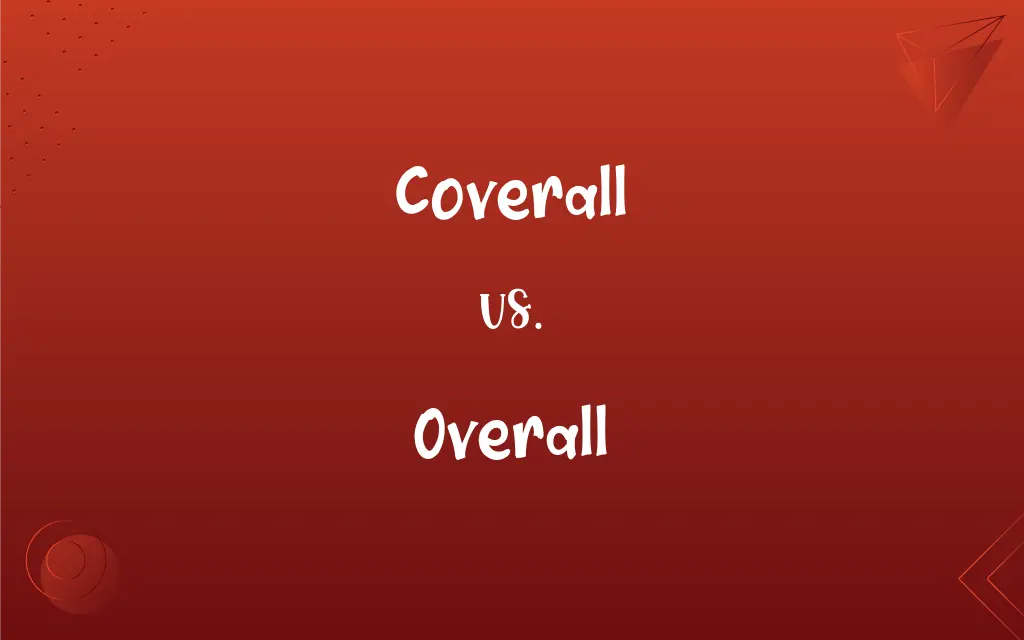Coverall vs. Overall: What's the Difference?
By Harlon Moss & Janet White || Updated on May 22, 2024
Coverall is a one-piece protective garment covering the entire body, often used in industrial or hazardous environments, while overall refers to a garment, usually with a bib and straps, worn over clothes for protection or as workwear.

Key Differences
Coverall is a one-piece garment that covers the torso, arms, and legs, providing full-body protection. It is commonly used in industrial settings, construction sites, and hazardous environments to protect the wearer from dirt, chemicals, and other contaminants. On the other hand, overall typically refers to a garment that consists of pants with an attached bib and shoulder straps, leaving the arms free. Overalls are often used in farming, gardening, and casual wear due to their practicality and comfort.
Coveralls are designed to provide comprehensive protection and are made from durable materials resistant to tears and chemicals. They are essential in jobs where safety and cleanliness are crucial. In contrast, overalls are more versatile and can be worn over other clothing, providing protection primarily to the lower body and torso while allowing for more movement and flexibility.
In terms of design, coveralls feature a zipper or button front and are meant to be worn as a single piece of clothing. They cover the entire body from the neck to the ankles. Overalls, however, are designed with a bib and brace, typically fastened with buckles or buttons, and are worn over other clothes. They can be paired with various tops, making them adaptable for different activities and weather conditions.
The usage of coveralls is more specialized, focusing on safety and protection in industrial and hazardous environments. Overalls have a broader range of applications, from practical workwear in agriculture and construction to casual fashion. They are often made from materials like denim or canvas, providing durability and comfort.
Comparison Chart
Design
One-piece garment
Pants with a bib and shoulder straps
ADVERTISEMENT
Coverage
Full-body (torso, arms, legs)
Lower body and torso, arms free
Common Uses
Industrial, hazardous environments
Farming, gardening, casual wear
Material
Durable, often tear and chemical-resistant
Durable, typically denim or canvas
Fastening
Zipper or button front
Buckles or buttons on the straps
Flexibility
Less flexible, more protective
More flexible, allows for layered clothing
ADVERTISEMENT
Coverall and Overall Definitions
Coverall
A protective garment covering the entire body except the head, hands, and feet.
The factory workers wore coveralls to protect themselves from chemical spills.
Overall
A garment consisting of trousers with a front bib and shoulder straps.
The farmer wore overalls to protect his clothes while working in the fields.
Coverall
Provides full-body protection.
The hazmat team donned coveralls before entering the contaminated area.
Overall
Commonly used in agriculture, gardening, and casual settings.
Overalls are practical for a day of gardening.
Coverall
Made from durable, resistant materials.
These fire-resistant coveralls are required for all welders.
Overall
Features buckles or buttons for fastening.
The straps of his overalls were fastened with sturdy buckles.
Coverall
Typically features a zipper or button front.
She zipped up her coverall before starting her shift at the plant.
Overall
Allows for flexibility and layering of clothing.
She wore a t-shirt under her overalls for a comfortable outfit.
Coverall
Used in industrial and hazardous environments.
Coveralls are essential for construction site safety.
Overall
Made from durable materials like denim or canvas.
His denim overalls have lasted for years despite heavy use.
Coverall
A loose-fitting one-piece work garment worn to protect clothes.
Overall
From one end to the other
The overall length of the house.
Coverall
A loose-fitting protective garment worn over other clothing.
Overall
Including everything; comprehensive
The overall costs of medical care.
Coverall
A loose-fitting one-piece garment that is worn over other clothing, especially one with trouser-like pants legs.
Overall
Regarded as a whole; general
My overall impression was favorable.
Coverall
A loose-fitting protective garment that is worn over other clothing
Overall
On the whole; generally
Enjoyed the performance overall.
Overall
Chiefly British A loose-fitting protective outer garment; a smock.
Overall
Overalls Loose-fitting pants, usually of strong fabric, with a bib front and shoulder straps, often worn over regular clothing as protection from dirt.
Overall
All-encompassing, all around.
Overall
Generally; with everything considered.
Overall
(British) A garment worn over other clothing to protect it; a coverall or boiler suit. A garment, for manual labor or for casual wear, often made of a single piece of fabric, with long legs and a bib upper, supported from the shoulders with straps, and having several large pockets and loops for carrying tools.
Overall
A garment, worn for manual labor, with an integral covering extending to the chest, supported by straps.
Overall
Everywhere.
Overall
Work clothing consisting of denim trousers (usually with a bib and shoulder straps)
Overall
A loose protective coverall or smock worn over ordinary clothing for dirty work
Overall
Involving only main features;
The overall pattern of his life
Overall
Including everything;
The overall cost
The total amount owed
FAQs
What is an overall?
An overall is a garment with pants and an attached bib and shoulder straps, often used in farming, gardening, and casual wear.
Where are overalls commonly used?
Overalls are used in farming, gardening, and as casual workwear due to their practicality and comfort.
What materials are coveralls made from?
Coveralls are made from durable materials that are resistant to tears and chemicals, such as polyester or cotton blends.
Do coveralls cover the arms?
Yes, coveralls cover the arms, providing full-body protection.
Do overalls cover the arms?
No, overalls leave the arms free, providing coverage to the lower body and torso.
Are overalls flexible?
Yes, overalls allow for more flexibility and can be worn over other clothing.
Where are coveralls commonly used?
Coveralls are commonly used in industrial settings, construction sites, and hazardous environments for protection.
What is a coverall?
A coverall is a one-piece protective garment covering the entire body, used in industrial or hazardous environments.
How are overalls fastened?
Overalls are fastened with buckles or buttons on the shoulder straps.
Are coveralls flexible?
Coveralls are less flexible and are designed for maximum protection.
Can overalls be worn casually?
Yes, overalls can be worn casually and are often seen in fashion trends.
Do overalls provide full-body protection?
No, overalls provide partial protection, primarily to the torso and lower body.
What is a common feature of coveralls?
A common feature of coveralls is their full-body design with front fastening.
What materials are overalls made from?
Overalls are typically made from durable fabrics like denim or canvas.
How are coveralls fastened?
Coveralls are usually fastened with a zipper or buttons along the front.
Do coveralls provide full-body protection?
Yes, coveralls provide protection from the neck to the ankles.
Are coveralls used in hazardous environments?
Yes, coveralls are essential in hazardous environments to protect against contaminants.
Are overalls suitable for heavy-duty work?
Yes, overalls are suitable for heavy-duty work, especially in agriculture and construction.
What is a common feature of overalls?
A common feature of overalls is the bib with shoulder straps, providing a practical and comfortable fit.
Can coveralls be worn casually?
Coveralls are typically not worn casually; they are designed for specific protective purposes.
About Author
Written by
Harlon MossHarlon is a seasoned quality moderator and accomplished content writer for Difference Wiki. An alumnus of the prestigious University of California, he earned his degree in Computer Science. Leveraging his academic background, Harlon brings a meticulous and informed perspective to his work, ensuring content accuracy and excellence.
Co-written by
Janet WhiteJanet White has been an esteemed writer and blogger for Difference Wiki. Holding a Master's degree in Science and Medical Journalism from the prestigious Boston University, she has consistently demonstrated her expertise and passion for her field. When she's not immersed in her work, Janet relishes her time exercising, delving into a good book, and cherishing moments with friends and family.































































